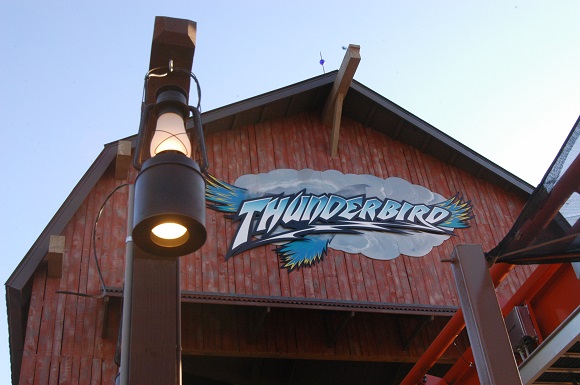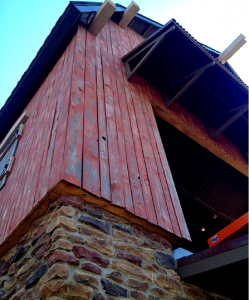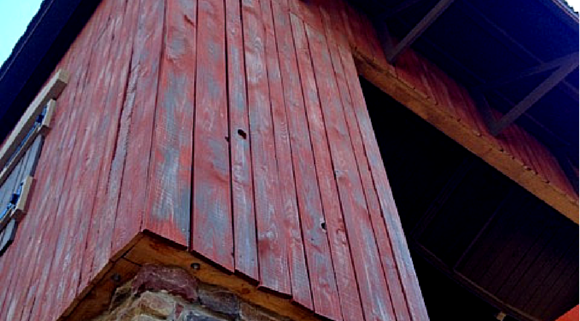Why are Barns Red?

Thunderbird roller coaster only at Holiday World & Splashin’ Safari. Ride theming and integration by Bleck & Bleck Architects.
Why are barns red? Why are shutters green and porch ceilings blue? The answers may surprise you. And then again, maybe not. In the past, people made paint color decisions much the same way that we do today: based on budget, availability, personal taste, utility, and sometimes superstition.
Red Barns
In the old days, many barns were painted red because it was cheap, readily available, protective and decorative. Red paint is made with red ochre, a compound of iron and oxygen (iron oxide) that is common and plentiful on earth, especially where the soil is well drained. According to archaeology expert K. Kris Hirst, ochre is the oldest known natural pigment. Ochre was used prehistorically as a pigment for painting on rocks and pottery, as well as tattoos. Paint made with red ochre and linseed oil was used by farmers to protect their barn wood from the elements. Farmers found that the paint did not fade readily and paint made with synthetic red ochre continues to be used extensively today as a metal primer.
 Midwesterners love barns; it’s a symbol of our farming heritage. It’s no wonder the iconic red barn was chosen to be the perfect launching site for Holiday World’s new Thunderbird roller coaster. Located in the park’s Thanksgiving-themed section, the new coaster’s theming connects the Native American legend of the Thunderbird with the local esthetic of a Midwestern farm.
Midwesterners love barns; it’s a symbol of our farming heritage. It’s no wonder the iconic red barn was chosen to be the perfect launching site for Holiday World’s new Thunderbird roller coaster. Located in the park’s Thanksgiving-themed section, the new coaster’s theming connects the Native American legend of the Thunderbird with the local esthetic of a Midwestern farm.
When we travel from the Midwest to Tennessee, Kentucky and Virginia, we notice that the barns are black – not red. In these areas, tobacco is a common crop. Farmers cure the tobacco leaves by hanging them in the barns where they are air or smoke cured in black barns. The black paint increases the temperature in the barns, aiding in the crop curing.
Green Shutters
What about green shutters? The history of shutters seems to indicate that people used dark paint to imitate the window opening itself. In some regions of Italy, zoning dictates that shutters must be dark colors such as dark brown, black, gray or green. Most all buildings in Italy have shutters, and they’re made by hand. In a past issue of Southern Living, there was a nice article about the history of classic southern paint colors. According to the article, after the Civil War, the color-loving residents of Charleston mixed yellow and green paint with Union-issued black paint to create “Charleston green”. We have seen this color used extensively throughout the south on ironwork, shutters, and doors.
Dark green shutters look great against a neutral background wall color – see some terrific examples and get inspired to paint your shutters in this article in Gardenista.
Blue Ceilings
Blue painted porch ceilings are a classic. In the South and coastal areas, porches are common and ceilings have historically been painted blue. We’ve always believed that blue was a great color for porch ceilings because it mimics the open sky. According to Sherwin-Williams, people also paint porch ceilings blue for a variety of superstitious reasons. Some people believed that blue was a harbinger of good luck or that blue looked like water and scared away evil spirits or “haints”. Some people swear that blue paint repels insects. This may be an idea handed down over the generations because early blue paint formulations were made with lye, an insect repellant.
Historically, a variety of blue shades have been used, from classic haint blue to pool blue and even turquoise blue. You will want to use a shade that compliments the style of your home. When choosing paint, consider your budget, the availability of your preferred shade, and the quality of the formulation. Professional painters will have their own preferences and will be able to guide you as well.



